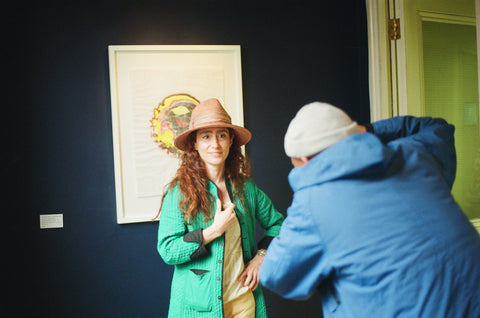'Art in the Age of Now' is an exhibition you don't want to miss! The group exhibition has totally transformed Fulham Town Hall into an explosion of contemporary art and live events.
Interviews by @Stooki
Photography by @PurpleContrast & @DJ_Lukey
All events for the final week are listed here: https://linktr.ee/fulhamtownha
We had a chat with some of the female artists exhibiting their work at the show. We gained a deeper insight into the inspiration behind their works, how Covid-19 affected their creative process and whats next for this mega talented group of artists… 🎨⚡👀
Meet The Artists...
Anna Kenneally
Anna Kenneally is a London based artist, represented by Fredericks & Freiser New York. Annas recent shows include Frieze New York and ‘Four Artists’ at Fredericks & Freiser. Anna's quixotic figures are sequestered at the fringes of society. Evoking a Victorian Gothic melancholy, they radiate the aesthetics of darkness as they navigate uncharted surroundings like vagrants picking over decimated landscapes.

1. Who are you? What do you do?
My names Anna Kenneally I’m a painter based in London. I make great big figurative oil paintings.
2. Tell us about your work and your inspiration?
I mainly work in acrylic and oil. I’d say a lot of my inspiration comes from female characters, sometimes these are invented or partly inspired from books or films. I’m very interested in subcultures and certain aesthetics genres such as gothic and grunge and how these can be translated into paint.
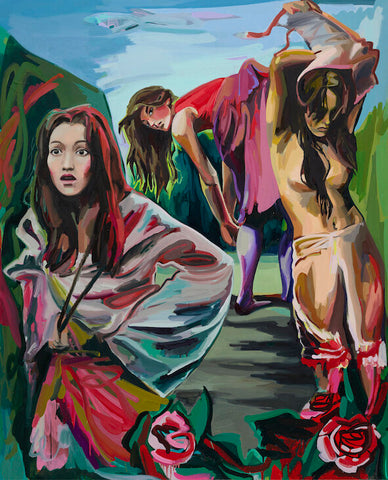
3. How has Covid-19 affected your creative process?
I found Covid-19 and the lockdowns to be very important for my work. I think they really affected my work ethic quite positively, I was very productive. I think it made me work in a very different ways. At times I wouldn’t have the same access to the same sort of inspiration, you wouldn’t be able to visit a gallery or meet friends and have constructive conversations. I also work quite a lot from drawings and photographs of friends. So not being able to do that was disruptive but it made me work in different ways. I work a lot from collage and I piece together compositions through that, so i think i did that to a greater extent.

4. What are your plans or the rest of 2021?
I’m currently making works for my solo exhibition in New York January 2022 at Frederick and Freezer gallery, that I’m very exited about! At the moment I’m in the early stages of making those works. I’m also starting at Turps Banana Art School September because i think coming out of this interesting period we’ve all been through it would be great to be around other artists instead of being alone at my studio for so long.
5. Where can people find more of your work?
Nic Mac
Nic Mac is an Illustrator and Mural Artist, based in London. Who likes to explore themes such as Mental Health and the Environment. Aiming to spread positivity as well as making sure not to shy away from some of the darker truths in order to help with awareness and to make sure that people who are struggling know that "they are not alone". She also writes poetry and makes videos about the art, in order to further aid her storytelling.

1. Who are you? What do you do?
Hey I’m Nic Mac, I’m an illustrator from London. I do lot’s of bold, colourful, digital illustrations a lot of the time. But I’m starting to work more with paint, canvases and murals at the moment as I’m really enjoying getting back into more tangible pieces instead of just the digital stuff.
2. Tell us about your work in this exhibition? What was your inspiration?
I focus on the theme of mental health a lot of the time, as that’s the main subject that I like to communicate the most. I want to spread positivity but also share and showcase the darker and more negative aspects, as I feel that we generally hide that side of things too much and it needs to stop, as it’s important to share the truth and talk about these things with honesty.
This exhibition mainly centres around mental health and raising awareness. I was lucky enough to work with David Oku on this mural, we spent two days and just had so much fun improvising this piece that you see.

There's two parts to the mural, the darker side which is where I focused on creating a twisted figure, that highlights and represents the fact that sometimes, we ourselves, can be the reason why we’re so trapped, because the limbs have essentially wrapped themselves in knots. And the other part is the more positive part where David shows how if we look within, we can discover that there is positivity inside. This piece tries to encourage people to see that the truth is, no matter what, there is good inside and we just have to find it and believe it.
I also wrote the poem that is on the mural:
“Open Mind,
Searching for answers, others can’t find.
Listen to your heart, for it’s fast to remind,
That to love yourself, you must first be kind.”

3. How has Covid-19 affected your creative process?
Like everyone I had so many plans that had to be cancelled because of the limitations that have been put in place. The hardest thing that I struggled with the most was the fact that I get inspiration by going out into busy places with lots of people. I love people watching, I love being around London and especially at the beginning of a project when I go exploring. I normally go out and about with a sketchbook, notebook and go to a coffee shop or a gallery. I getting the train, there’s just something about them and being around people. So due to Covid-19 and not being able to be in those environments has been hard. I've definitely found it quite strange to get into that flow because that was my way of doing it, but I know most of the time I've been ok. I've been pretty lucky still being able to work and stay productive at the same time.
I really wanted to travel in 2020. I really want to spend some serious time in Spain, I’m half Spanish so I want to brush up on the language and just be around that culture more and learn a little bit more. I’m looking forward to just being in a different environment and I think Covid-19 actually bought that about, I want a change of scenery.
4. What are your plans or the rest of 2021?
I’ll be doing a mural at Upfest, the Street Art Festival, in Bristol, this year. I’m also looking forward to the Illustration World Championships, which will be in Coal Drops Yard, Kings Cross. I have competed for the last two years, But this year is different, there is a Digital tournament too, which will be very different but I’m excited for it. Then, the main plan for 2021 is just to do more murals and more travelling, to just get out again and see some things!
5. Where can people find more of your work?
Ariadna Dane
Ariadna Dane is a British Russian visual and multi-media artist living and working in London. Having grown up in Siberia and travelled extensively, the artist discovered a connection to nature which became a source of inspiration for her evolving art practice. Dane uses mixed media, collage and cutouts to produce contemporary pieces that capture organic forms and structures. She is currently exploring how some of these traditional mediums can be used in combination with technology.

My name is Ariadna Dane. I’m a visual and a multimedia artist and in this exhibition I have three artworks on show which are made with ink on paper and they also enhanced with augmented reality.

2. Tell us about your work in this exhibition? and your inspiration?
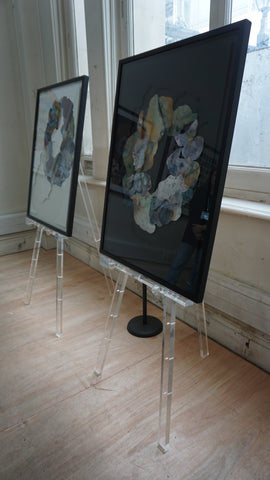
3. Why did you decide to include an augmented reality in these artwork?
I have been interested in augmented reality for a while and I think during the lockdown I had both the time and space to experiment with it. I think digital art has gained a lot of interest in the last few months and it's in the spotlight right now so I think it's great timing to experiment with this and see how I can take my work to the next level. I see augmented reality as the bridge between the physical and the fully digital world.
4. What are your plans or the rest of 2021?
I have a few personal objectives first of all I'd really like to make my practice more sustainable and my work more sustainable. To be sustainable in ecological terms but also in financial terms. I've started making art relatively recently and I really see this is a long-term career. So for example I have a mentor now I’ll be working with for the rest of the year which I'm really looking forward to. I also want to continue honing in on my digital art skills and my augmented reality work to make it work even more interactive and have a better connection with your audience.
5. Where can people find more of your work?
Elena Cecchinato
Elena Cecchinato was born in Venice, Italy. She studied painting at Korio University, in South Korea before obtaining a Master’s degree in the History of African and Asian Art from Soas, University of London. Her work explores the immanent reordering that exists between our inner experiences and the outer occurrences we encounter on our daily cultural practices.

1. Who are you? What do you do?
I’m Elena a multimedia artist. I work with many different mediums, whether it's drawing, painting ceramics, writing and installations depending on what subject is in my mind. I try to find the balance medium that works best.
2. Tell us about your work in the exhibition? What was your inspiration?

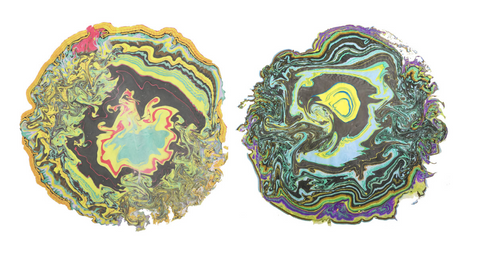
3. How has Covid-19 effect your creative process?
I had more time to experiment and I was meant to do an artist residency but because of Covid-19 I couldn’t travel. But nevertheless I kept going and working a Zoom,WhatsApp and sharing platforms. At the moment I'm working with water, so I'm drawing with water onto a black sheet of paper in front of the sun. I do this for an hour and or so and and every time I draw the drawing disappears, so I really like this idea of transformation and change and nothing really stays the same. I really try to capture the change. So this period has been good as it allowed me the time to create.

4. What are your plans or the rest of 2021?
I'm preparing a show in the city of Oxford and Padua, Italy. They are the two cities of culture, and I'm from Venice and the artist I collaborate with Timothy Ellis is from Oxford. We are combining together going to make more types of work so will continue to work on our Liquid Sonic Abstraction project.
5. Where can people find more of your work?
Rachel Megawhat
Rachel Megawhat is a London based artist that defies easy categorization. Known, in part, for flower photographs she returns to ACBF with a new series of floral polaroids - 'Night Garden Honesty and Bluebells' . Also a brand new series of paintings, small oils on canvas, studies of the Beasts of the Houses of Parliament.

1. Who are you? What do you do?
My name is Rachel and I’m a artist.
2. Tell us about your work and your inspiration?
These paintings of my local area but I live in which is in Central London. I live quite close to the new skyscraper swimming pool. It’s a very fast moving area in terms of developments and I l primarily worked as a photographer and I like to paint as well. I started to make paintings as well as photographs because they're more longer-lasting. A lot of these paintings are of locations that have been developed already or demolished.

3. How has Covid-19 affected your creative process?
I suppose I did go back to being hyper local again. In what i was focusing on. It felt like I went back in to the range of when I had very small children and lived on the block.
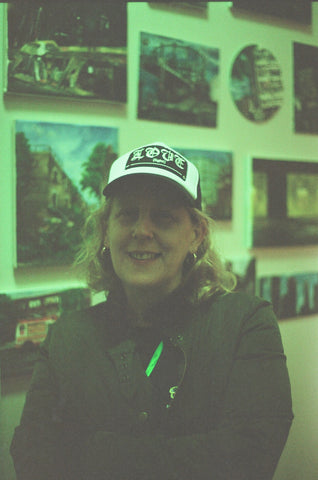
4. What are your plans or the rest of 2021?
Basically waiting to see Aliens come out of America on the 21st of June. Who else is waiting for anything else? I mean what can happen next haha?.. Then just take it from there.
5. Where can people find more of your work?

Following a successful photography career, Rachel Megawhat has progressively emerged her name into artistry. She expresses a dystopian aesthetic into her artworks by detailing out urban landscapes of Britain’s capital. Rachel explores the authenticity of her hometown as Central London ignites the impulse to brush up an empty canvas, the city being her muse during the winter lockdown. “They are me trying to make sense of the nonsensical situation of living in a locked-down where luxury construction continues unimpeded.” - Rachel Megawhat.
The idea of her art unravelling a deeper narrative holds somewhat of importance. The artist maintains a balance between a form of art that holds a story behind it and art that shines in the spotlight on its own. She started as a photographic assistant as a teenager and completed a foundation art school year in her early 20s. The artist has managed to balance both specialisms throughout her life, mastering the two equally.
Rachel dives deeper into the activity of photographing flowers by embracing a new perspective when associating terms with flowers. Rachel highlights how flowers can signify the key moments of life such as births, deaths and marriages. With this unique perspective in place, she planned to foretell the eternal truths and beauty to showcase an understanding of the current problems in our society today.
Before dedicating her time to curate art based on the theme of “How internet technology would impact society in the early 2000s, Rachel kickstarted her photography venture by taking up training in a photography studio. Progressively, she secured her achievement as an established political photographer later on in her career and is an honourable member of the British Press Photographers Association.
Check out her website: Somethingtoseehere.com and her Instagram: @somethingtoseehere to keep up with her latest ventures.
Written by Tasnim H.
---
Fipsi Seilern

1. Who are you? What do you do?
My name is Fipsi. I’m an artist and street artist. The work here in this room is full of mostly paintings by I do a lot of other work in my practice.
2. Tell us about your work and your inspiration?
It's kind of a assortment of different bits of my artistic recent past. I made the selection for this collection of works, based on the location and the space here as it has a slightly creepy atmosphere down in the Vault. So I tried to gather some works that fit that atmosphere a bit, so they are from different series and I found a way to curate them all together. So it's a bit of the mish-mash. I've also got my portraits here and I’ve mixed classical portrait paintings with street art. Which I got into a bit later after going to painting school. I've merged things togetherin several of the pieces, so I have little cowboy vandalising a classical head which is a play on idea on the boundaries between art, vandalism, street art and graffiti writing.

3. How has Covid-19 affected your creative process?
I think the main thing is that it happened smack bang in the middle of doing my master's degree. That had to be paused but the school is really kind, so they postponed it and then we had 6-months off and went back in September. I had a studio space to work in up until January then we got hit with the other lockdown. But that's probably how it affected me most because I was in the middle of studying, but I just worked from home and painting which was good.
4. What are your plans or the rest of 2021?
Since we can't go on holiday, I’m going to carry on working from my studio. I’ve got a couple of exciting projects coming up, painting commissions and a project that involves macabre painting which is in the kind of similar to the works on show here. I have a solo exhibition in October in a church called the Florence Trust, it's not a functional church but they do artists residencies and they have artists studios. It’s really perfect for some of my my other art works and I'm really excited about it. Then we have our degree show end of July, so quite a lot so I guess but we're ready halfway through the year which is crazy!
5. Where can people find more of your work?
---
Elinor Fahrman
ELINOR FAHRMAN was born in Stockholm, Sweden. Growing up in an ordered world, she fell in love with the cacophony of the disorganised London at the age of 14 and has lived there since 1995. She travels the world as a DJ and takes her sketch book wherever she goes. Her work has been commissioned by magazines, record companies, set designers and music festivals as well as being displayed in galleries across London, Japan and Sweden. In late 2019 her first children’s book was published by Bonnier Carlsen. She finds beauty in the unusual, the neglected and discarded, giving life to inanimate objects. Her illustration style is self-described as ‘wonky’, but her line is always strong, creating work that is magical and vibrant.

1. Who are you? What do you do?
I'm Elinor Fahrman and I'm an artist. When I’m not making these massive backdrops I do illustrations for magazines. They are on a much smaller scale and I'm also a DJ and I've been playing at the exhibition and all over the place.
2. Tell us about your work and your inspiration?
This room is the history of Gaz's Rockin' Blues at Notting Hill Carnival. So every year we pick a different theme and we also design the whole system to look like various themes. One year we had a Gypsy theme and we’ve done the roaring 20s where the whole block got decorated in that theme. Like this one behind me is based on the Windrush. So the stage was a massive boat and then I downloaded photographs of Tilbury Dock in the 1940s and put everything together. So every year I make a different backdrop for carnival.

3. How has Covid-19 affected your creative process?
The lockdown has really affected me as a DJ because I haven't been able to play any gigs. But it hasn’t affected my drawing as much. I’ve found it quite hard to motivate myself because of we have had so much free time, but drawings are the one thing you can do on your own.
4. What kind of music do you DJ?
I play a lot of 1940s/50s music, Blues, RnB, early Jamaican records 45" singles only. A lot of 60s Soul and Rock n Roll.

5. What are your plans or the rest of 2021?
I’m looking forward to playing more gigs now. I have a festival at the end of July called the Elephant Camp which is great. I won't be doing a backdrop for Nottinghill Carnival this year unfortunately, but I'll be doing lots of magazine illustrations and a lot of Swedish magazines because I'm Swedish.
7. We heard you recently released a children's book please tell us more about that?
Yes! I had a children's book come out in Sweden last September. It's called Stella in Paris. Head here to learn more about it.

6. Where can people find more of your work?
Anne Windsor

1. Who are you? What do you do?
My name is Anne Windsor and I’m the hanger of artwork I deal with lots of other artists as well on the basis of showing their work. I work closely with curator Ben Moore and I hung a lot of the pieces throughout the exhibition.
2. Tell us about your work and your inspiration?
I have four pieces in show that I consider to be portraits because they're about the characters rather than the way they look. I'm quite interested in the idea that you can be introduced to someone and then you can forget their name, they go away and it takes various meeting and bits of information to come about each other to build the actual friendship. I’m interested in the way the memory of someone takes time to build and I’ve focused on the internal and emotional side through these artworks. I’ve tried to capture the community aspect and the traits of the individual and society as a whole. My work is about the way people interact with each other, and as an artist it's my interpretation and commentary on that.
3. How has Covid-19 affected your creative process?
Is has narrowed it down in a away in the art area. Because obviously during the lockdown people weren't able to go to galleries in the same way, so hanging shows weren’t so much in demand. I suppose for my own personal work it's about the interaction between people, so my work became smaller and a little more intense, so it slightly changed direction. I rely on getting to know people as well, so you still keep connections through the phone or the internet but it’s more remote. I'm very much someone who likes to very much get so to know someone face-to-face. But I also the work is all paint, so I like to show that revealing. The I apply thick layers of paint and then take a sharp knife to it cut it back to reveal something of the attention of the work.
4, Why did you decide to bring a 3D element into your work?
Because relationships are three-dimensional, people are three-dimensional and it's not just the two-dimensions that you see.

5. What are your plans or the rest of 2021?
Hopefully more shows like this and more pop-ups. There are lots of empty shops so I'm hoping creativity will just blossom because there are a lot of empty spaces. I’m hoping proprietors will just let people make use of the space and I'll let people have a bit of a good time and blossom in that area. I’d like to be part and parcel and help other artists out there to just bring a bit more creativity back.
6. Where can people find more of your work?
Raghad Mardini
Raghad Mardini is Founding Director of Litehouse Gallery, part of her ongoing commitment to showcasing the work of Syrian contemporary artists, developing their market, and integrating them further into the international art scene.
Born in Syria, Mardini holds a Masters in Structural Engineering and BSS in Civil Engineering from Damascus University, where she has designed and restored many houses. In 2008 she moved to Lebanon.

1. Who are you? What do you do?
My name is Raghad Mardini I am a civil engineer born in Syria. I have founded an art residency program in Lebanon to support the young Syrian artists after the war started. A lot of them had to take jobs in construction and restaurants etc instead of creating art. From my belief in the importance of protecting art and artists I had the idea to create a art residency I worked and transformed these historic stables in the mountains into a art space.
I started the program in 2012 or for 4 weeks full board accommodation, also I supplied the artists with the materials for their work and the most important part for me was their freedom of speech. After that I supported them, curated exhibitions and took their work world wide.
2. Tell us about us more about the projects you have worked on?
During three years we hosted 65 artist and we took our shows to Washington DC in 2014 we also had a show in Berlin and Jordan. We published a book in support of you and HDR called the ‘Syrian Art in Hard Times’. We also made a documentary about the artists that stayed at the artists in residencies and it was supported by the British Council called ‘Art of Resilience’. In 2015 the situation in Lebanon became hard so I moved to London with my two children and started a master's degree at Westminster University in ‘Museums & Contemporary Culture’ and after completing the last days I started the Lighthouse Gallery in support of Syrian artists and to show their works. We got involved with this exhibition to build bridges between Syrian artists and British artists and this show was a great opportunity for us to be part of this community, and link to the underground art scene here in London and create a dialogue between the works.
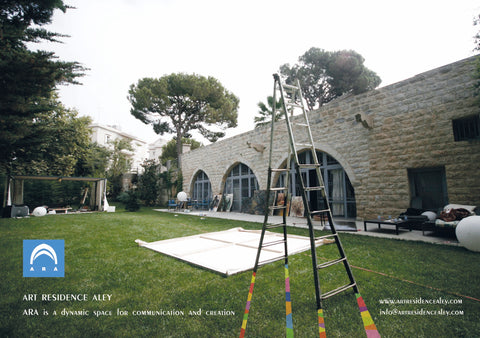
3. Tell us about the artists you selected for this exhibition and their work?
We are showing works from six different artists. The three female artists we are exhibiting include:
Farah Azrak
Farah Azrak was born in Damascus, Syria in 1986, and graduated in Fashion Design at the Istituto Marangoni in London, UK in 2013. Her career has taken her from working at Alexander McQueen to The Women’s Embroidery Workshop in Shatila Refugee Camp, from Harpers Baazar to dance therapy. She now lives and works in Beirut, Lebanon.

Farah Azrak, we have five of her photo collages, she is currently living in exile in Lebanon. She is a displaced artist and this artwork is called flying carpet, it's colourful it's like it's defying all the difficult circumstances that they are living in in exile by creating the beauty.
Living in the state of anxiety engendered by the constant fluctuation of place and belonging, she reaches into her subconscious to create symbolist collages. The dense and decorative surfaces of these are rich, but not static. They are full of movement and humour, channeling her eclectic experiences and interests. Dazzling gods, kings and beauties preen, pose or bounce along in tanks. Her characters often seem to be performing, as if in a play or film, or perhaps playing up to the camera lens, composing themselves for a fashion shot or for a film poster.

Hiba Al-Akkad
Hiba Al-Akkad was born in Damascus, Syria in 1981, graduated from the Faculty of Fine Arts at Damascus University in 2006, and lives and works in Gothenburg, Sweden.
During the Syrian uprisings Akkad stopped painting: “I cared about what was happening around me, so I went to be with the people.” The crackdown forced her to spend more time at home, but, as she explained.

The artwork below is called flying carpet, it's colourful, it's light and it's defying all the difficult circumstances that they are living in in exile by creating beauty.

---
Iman Hasbani
Iman Hasbani is a multi-media experimental artist born in Swieda, Syria. She obtained her Masters Degrees in Fine Art from Damascus University in 2007, and in Dialogue Through Art from the University of Beirut. Since 2008 her work has been concerned with social issues and the lives of women. From 2011 for two years she did not do any of her own personal work, instead focusing on using art therapy to help children affected by the war in Syria. She now lives and works in Berlin.

Her work is in room number 7. It’s a installation work called ‘Separation’ and it's a photograph of a girl carrying her pillow looking between the tanks trying to find a safe place to put down a pillow and sleep. This artwork is a memory from her childhood where she was in Syria, and after that she lost the feeling of security.
Some of Hasbani’s central themes are memory, dreams, transience and the loneliness of women in a closed society. In her early works she collected stories of women who had committed suicide or died alone and whose diary entries had been found posthumously.
4. What are your plans or the rest of 2021?
We are working on a new exhibition that is going to happen at the end of the year. We are showing the work of a female artist I hope it's going to you the unexplained more about I like and Syria and especially in the 90s before the war where well Evans diss society of beautiful women wearing beautiful dresses going to weddings and dinners and invitation in this will be in conversation with art works of the bath a card who uses textiles colours in her paintings and we are working on at exhibition at the moment.
5. Where can people find more of your work?
Artists wore
ULTRAONYX Ring - Gold

CONNECTION Necklace - Gold

HAVANA Bracelet - Silver

—————————--
Production by: @Maya_Mihoc











